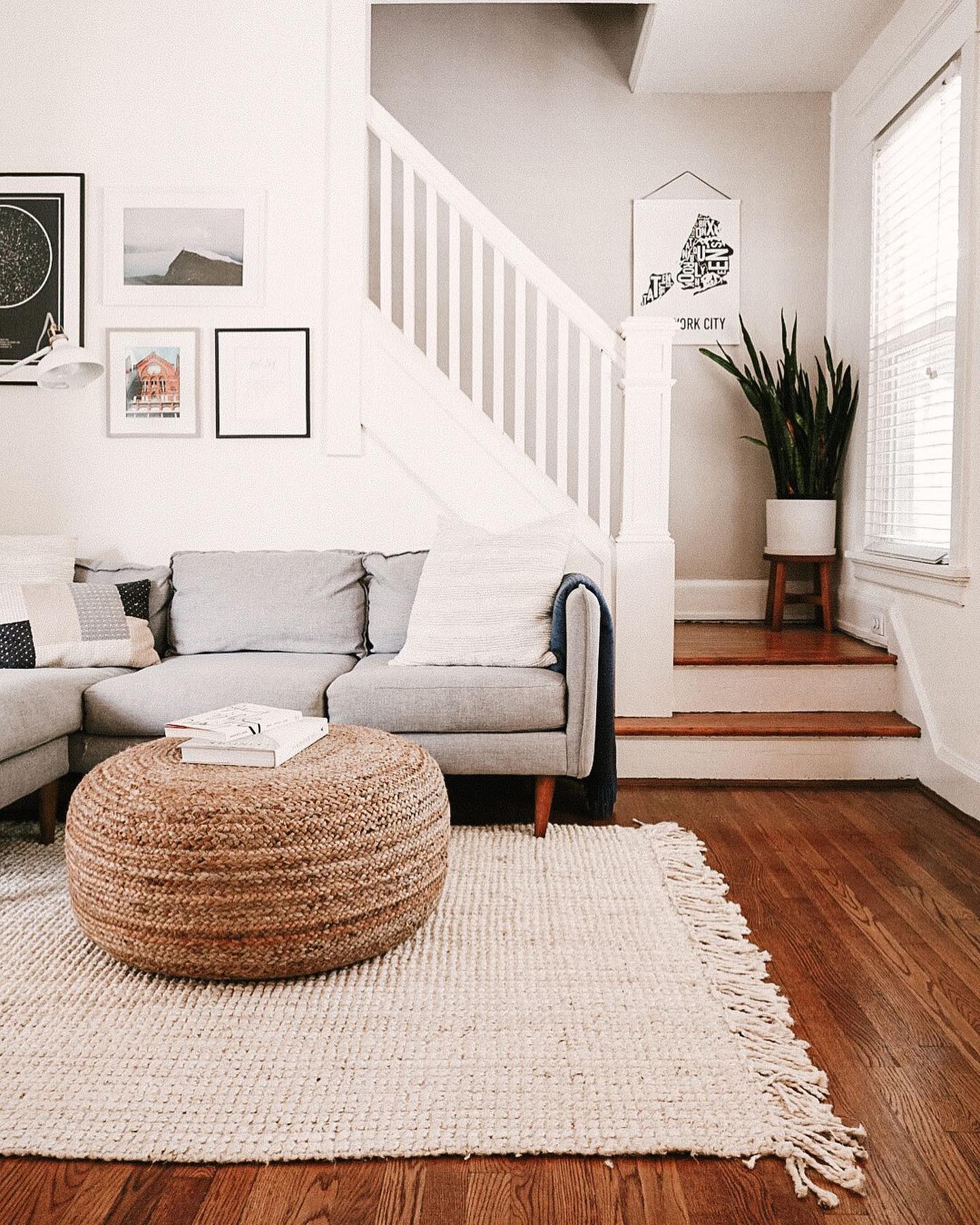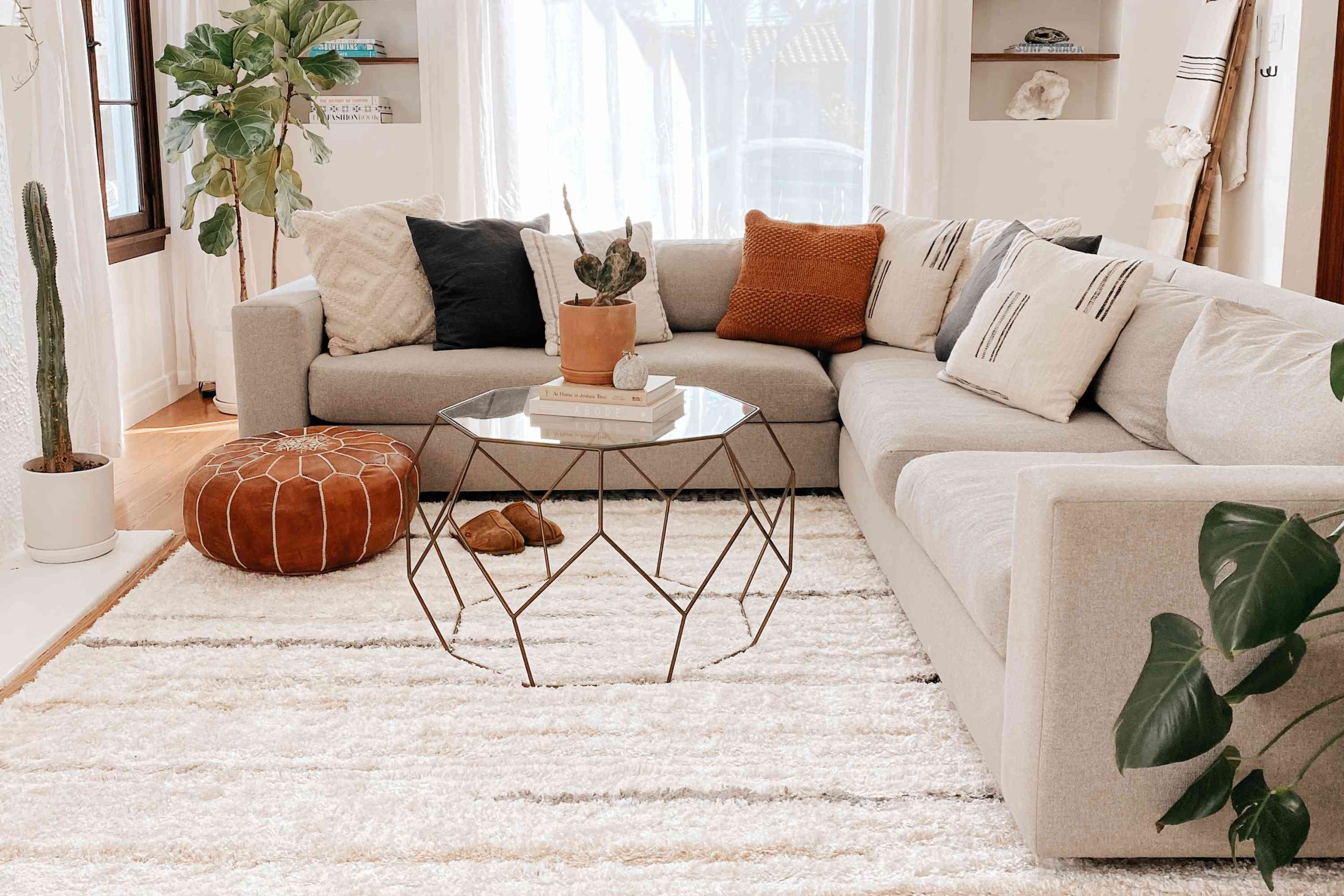A living room rug should cover at least the central seating area. A properly chosen rug can be a defining element of a well-designed living room. How Much of a Living Room Should a Rug Cover, let’s explore
It adds warmth, comfort, and style to the space. When choosing the right rug for your living room, one important aspect to consider is the size. The rug should cover at least the central seating area, ensuring that all furniture pieces are grounded within its boundaries.
Placing just the front legs of the furniture on the rug is a popular design choice, but it is also acceptable for the rug to extend further, fully encompassing the furniture. By following these guidelines, you can create a visually appealing and harmonious living room where the rug serves as both a functional and aesthetic element.
:max_bytes(150000):strip_icc()/area-rug-dos-and-donts-p2-1977449-b4c4f615071f4b0d85dd53929daecfc6.png)
Credit: www.thespruce.com
Importance Of Rug Size In A Living Room
Choosing the right rug size is crucial for a balanced living room. It should cover the main furniture pieces to create a cohesive and spacious feel, while leaving a border around the edges for a visually appealing look.
Choosing The Right Rug Size
Choosing the right rug size for your living room is crucial to create a harmonious and well-balanced space. A rug that is too small can make the room feel disjointed, while a rug that is too large can overwhelm the room and make it feel cramped.
When selecting a rug size, consider the dimensions of your living room and the furniture you have. Ideally, the rug should be large enough to anchor the space and fit comfortably under the front legs of the furniture.
To determine the optimal rug size, measure the seating area of your living room and allow for at least 12 to 18 inches of rug space around the furniture. This creates a visually appealing and functional layout.
Creating Balance And Proportion
Proper rug size is essential for creating balance and proportion in your living room. A rug that is too small in relation to the furniture can make the seating area appear disproportionate and awkward.
On the other hand, a rug that is too large can overpower the furniture and make it seem small and insignificant. The key is to find a rug size that complements the scale of your furniture and enhances the overall aesthetic of the room.
Consider the size of your sofa and chairs when choosing a rug. The rug should be large enough to extend beyond the seating area, creating a defined space and visually connecting all the elements in the room.
Defining Living Room Zones
Another important aspect of selecting the right rug size is defining different zones within your living room. A well-placed rug can help create distinct areas for seating, dining, or even a cozy reading nook.
When determining the rug size for different zones, consider the function and layout of each area. For the seating zone, choose a rug that accommodates the sofa, chairs, and coffee table, and allows for easy movement around the furniture.
If you have a dining area within your living room, make sure the rug is large enough to fit the table and chairs comfortably. This not only helps define the dining space but also protects the flooring beneath from any spills or scratches.
Guidelines For Selecting The Proper Rug Size
When it comes to creating a cozy and visually appealing living room, selecting the proper rug size is crucial. The right rug can tie the space together and provide a sense of cohesion. By following certain guidelines, you can ensure that your rug complements the layout and size of your living room
Consider Furniture Placement
Before choosing a rug size, consider the placement of your furniture. Determine whether you want all the legs of your furniture to sit on the rug or just the front legs. This decision will affect the size of the rug needed for your living room. Ensure that the rug accommodates the core furniture pieces in the room.
Measure Your Living Room
- Measure the dimensions of your living room to determine the appropriate rug size. Take note of any architectural features or obstructions such as fireplaces or doorways. This will help in choosing the right shape and size for your rug, ensuring a balanced and harmonious look.
- Use painter’s tape or a bedsheet to outline the desired rug size on the floor to visually assess the scale and layout. This can aid in gauging how the rug will fit within the space and complement the overall aesthetic.
Determine Rug Shape And Style
- Select a shape and style that complements the existing decor. A rectangular rug typically works well in a standard living room, while a round rug can add visual interest to a space. Consider the pattern and texture of the rug to enhance the room’s ambiance and tie the design elements together.
- Ensure that the rug provides sufficient coverage without overwhelming the room. It should fill the space without feeling cramped or appearing too small in relation to the surrounding furniture and decor.
Rug Placement Options
When it comes to choosing the right rug size for your living room, there are a few rug placement options to consider. The size and placement of your rug can greatly impact the overall look and feel of your space. To help you make the best decision, we’ll explore three popular rug placement options: Rug Completely Under Furniture, Front Legs of Furniture on the Rug, and All Furniture Off the Rug.
Rug Completely Under Furniture
If you’re wondering how much area should a living room rug cover, the option of placing the rug completely under the furniture can be a great choice. The rule for rug size in this placement option is to ensure that the entire furniture set, including the sofa, chairs, and coffee table, is placed on the rug. This creates a cohesive and grounded look, making the rug the focal point of the room.
To achieve this placement, you’ll need a rug that is large enough to accommodate the furniture arrangement. The perfect rug size for a living room with this placement option would be one that extends beyond the outer edges of the furniture. This creates a harmonious visual balance and allows for comfortable movement around the room.
Front Legs Of Furniture On The Rug
Another popular rug placement option is to have only the front legs of the furniture on the rug. This creates a sense of openness and flow in the room. When determining the rug size for this placement option, it’s recommended to choose a rug that is large enough to accommodate the front legs of the furniture without overcrowding the space.
A common rule for rug size with this placement option is to have the rug extend at least six inches beyond the front legs of the furniture. This provides a visually appealing frame for the seating area and adds a touch of coziness to the room. So, if you’re wondering how much of a floor should be covered by an area rug with front leg placement, keeping this six-inch guideline in mind will help you find the perfect fit.
All Furniture Off The Rug
If you prefer a more spacious and eclectic look for your living room, placing all furniture off the rug might be your preferred option. With this placement, the rug acts as an accent and defines the seating area without covering too much floor space.
To achieve this look, choose a rug that is large enough to accommodate the entire seating area, leaving a border of flooring visible on all sides. This creates a sense of proportion and balance, while still allowing you to showcase your beautiful flooring.
| Rug Placement Option | What it Offers | Rule for Rug Size |
|---|---|---|
| Rug Completely Under Furniture | Cohesive and grounded look | Rug extends beyond the outer edges of the furniture |
| Front Legs of Furniture on the Rug | Sense of openness and flow | Rug extends at least six inches beyond the front legs of the furniture |
| All Furniture Off the Rug | Spacious and eclectic look | Rug accommodates the entire seating area with a visible border of flooring |
Ultimately, the perfect rug size for your living room depends on your personal preferences and the overall style you want to achieve. By considering these rug placement options and the respective rules for rug size, you can create a beautifully balanced space that reflects your unique taste and provides comfort for both you and your guests.
Common Mistakes To Avoid
When designing your living room, avoid the common mistake of choosing a rug that is too small. The rug should cover a significant portion of the room, creating a cohesive and visually appealing space. Avoid the error of selecting a rug that is too small and instead opt for one that covers most of the main seating area.
Choosing A Rug That Is Too Small
One of the most common mistakes people make when selecting a rug for their living room is choosing one that is too small. The rug plays a crucial role in tying the room together and creating a sense of cohesion. When the rug is too small, it can make the room look disjointed and incomplete. So, what is the perfect rug size for a living room?
The rule of thumb is that a living room rug should cover a significant portion of the floor, creating an anchor for the furniture. The rug should extend beyond the edges of the furniture placed on it, such as the sofa and chairs. This not only adds visual interest but also makes the space feel more inviting and cozy.
Leaving Excessive Empty Space
Another mistake to avoid when it comes to living room rug sizing is leaving excessive empty space around the edges. While it’s essential to have enough floor space exposed, having too much empty space can make the room feel unbalanced and under-decorated. The goal is to strike a balance between the rug and the surrounding floor, creating harmony in the space.
To avoid leaving excessive empty space, consider the size of the room and the furniture arrangement. A larger room with more furniture may require a larger rug to fill the space adequately. On the other hand, a smaller room with minimal furniture can benefit from a rug that covers a smaller area.
Ignoring The Room’s Scale And Proportions
Ignoring the scale and proportions of the room is yet another common mistake made when choosing a living room rug. Each room is unique, and its size, shape, and layout should be taken into consideration when selecting a rug.
A rug that is too small or too large for the room can throw off the overall balance and proportion. In a small living room, a large rug can overwhelm the space, while in a large living room, a small rug can get lost amidst the furniture. It’s important to measure the room carefully and choose a rug that complements its scale and proportions.
In conclusion, when it comes to selecting a rug for your living room, it is essential to avoid common mistakes. Choosing a rug that is too small, leaving excessive empty space, and ignoring the room’s scale and proportions can all detract from the overall aesthetic and functionality of the space. By considering the size of the room, the furniture arrangement, and the desired visual impact, you can select a rug that perfectly complements your living room and creates a cozy and inviting atmosphere.
Tips For Enhancing The Room With A Rug
When it comes to enhancing the aesthetics and functionality of a living room, choosing the right size and style of rug is crucial. A well-placed rug can tie the room together, elevate its overall design, and add a sense of warmth and coziness. Below, we’ll explore various tips for enhancing your living room with a rug, including using rugs to add color and pattern, layering rugs for visual interest, and utilizing rugs for sound absorption.
Using Rugs To Add Color And Pattern
Adding a rug to your living room is an effective way to introduce color and pattern into the space. When determining the right rug size for your living room, consider how much area should a living room rug cover? The general rule for rug size suggests that ideally, a rug should cover the majority of the floor space in your living room. To achieve this, measure the seating area and ensure the rug extends beyond the furniture in a balanced manner.
Layering Rugs For Visual Interest
Layering rugs can bring depth and visual interest to the living room. This technique allows you to play with various textures, patterns, and colors. When layering rugs, the perfect rug size for a living room depends on the existing furniture layout and the size of the room. Consider layering a smaller rug on top of a larger one to create a dynamic focal point in the room while adding an extra dimension to the overall design.
Utilizing Rugs For Sound Absorption
Rugs also serve a functional purpose in sound absorption, especially in larger living rooms with high ceilings. When contemplating how much of the floor should be covered by an area rug, consider incorporating rugs in areas where sound reflection and echoes are more pronounced. This not only enhances the acoustics of the room but also brings a sense of warmth and comfort.

Credit: www.rugsusa.com
:max_bytes(150000):strip_icc()/Retouched-Laura-Genevieve-horizontal-af3b84469eb848d99572faeda9950803.jpg)
Credit: www.thespruce.com
Frequently Asked Questions Of How Much Of A Living Room Should A Rug Cover?
How Much Of A Living Room Should A Rug Cover?
An ideal rug should cover at least the front legs of your furniture to create a cohesive look and define the seating area.
What Size Rug Is Best For A Living Room?
For a living room, a rug that is big enough to hold all the furniture and reach beyond the coffee table is the best choice.
How Does The Size Of The Rug Affect The Room?
The size of the rug can visually expand or shrink the living room. A larger rug can make the room feel spacious, while a smaller rug can make it appear cramped.
Can A Rug Be Too Big For A Living Room?
While there is no hard and fast rule, a rug that is too big for a living room can overwhelm the space and make it feel crowded.
Conclusion
To sum up, selecting the right rug size for your living room plays a crucial role in enhancing the overall look and feel of the space. By understanding the guidelines and considering the size and layout of your furniture, you can confidently choose a rug that creates a cohesive and inviting atmosphere.
With these insights, you can easily elevate the style and functionality of your living room with the perfect rug size.










